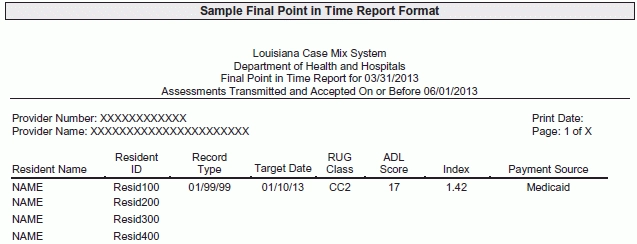Long-Term Care Survey Alert
Don't Miss This Chance To Impact Your Reimbursement
Complete your Preliminary Point In Time Report accurately with these nine steps.
If you miss the opportunity to file your facility’s Preliminary Point In Time Report and correct inaccurate assessments you could be damaging your facility’s bottom line. Use this report to your utmost advantage by checking these key items.
Note: Not all states provide a Point In Time Report, and in other states this might be called by another title. For example, Illinois provides a similar type of report generally referred to as a transaction form.
What Impact Does This Report Have?
At some time before receiving your final Point In Time Report, you’ll receive a Preliminary Point In Time Report, which allows your facility to determine whether you have any missing or incorrect records. And, depending on your state, you’ll have a review period to evaluate the records displayed on the roster, according to Myers and Stauffer LC in the June issue of North Carolina News.
According to the Louisiana Department of Health and Hospitals, the information on your Point In Time Report includes:
- Identifying information for the resident:
• Resident name (last, first; alphabetical order)
• Resident ID number
- Identifying information for the assessment/record:
• Record type (A0310A/A0310B/A0310F)
• Target date
• RUG classification
• ADL score (4–18)
- Additional information listed for the record:
• Case Mix Index (CMI)
• Payment source (Medicaid, Medicare, Other)
Important: Missing, inaccurate or incomplete MDS assessment data can affect the average CMI shown on the Point In Time Report and used in calculating the Medicaid rate. So reviewing — and correcting errors in — your Preliminary Point In Time Report is essential to your facility’s reimbursement.
Check Off These Review Items to Save Your Medicaid Reimbursement
Myers and Stauffer recommends following the steps below when you’re reviewing the Preliminary Point In Time report:
1. Determine if all the residents in the facility on the point-in-time date are listed on the report.
2. Determine that discharged residents on or prior to the point-in-time date are not included in the report.
3. Make sure that the most current assessment/record as of the point-in-time date is represented.
4. Ensure that each resident is identified only once. If the same resident appears as two separate residents, contact your state RAI coordinator for assistance in merging resident records.
5. Review any BC1 RUG classification. Keep in mind that assessments may have already been transmitted after the cutoff date of the Preliminary Point In Time Report and will automatically be listed on the final report.
6. Keep in mind that any missing or corrected assessments transmitted and accepted after the cutoff date will not appear on the report.
7. Review for missing or corrected assessments that may have been transmitted and not accepted by the QIES ASAP system. Review any errors, and then make corrections and retransmit, if applicable.
8. Review for accuracy of dates and/or reasons for assessment by following the RAI manual instructions for modifications and inactivation in Chapter 5.
9. Verify the accuracy of the payer source (Other) for Hospice or Vent/TBI.

Long-Term Care Survey Alert
- Technology Use:
Get Smart with Dementia Care Innovations
Here’s how technology can help you step up your game, improving care and survey results. [...] - Medicaid:
Don't Miss This Chance To Impact Your Reimbursement
Complete your Preliminary Point In Time Report accurately with these nine steps. If you miss [...] - Don't Forget to INTERACT
Interventions to Reduce Acute Care Transfers (INTERACT) is a quality improvement program developed by the [...] - PASRR:
Follow These Pointers to Master PASRR
Tip: The SNF is responsible for appropriate completion of PASRR. Correctly coding item A1500 — [...] - Patient Privacy:
Don't Let Terminated Employees Sneak Out With Patients' PHI
Yet another HIPAA breach reinforces all the crucial reasons why you should encrypt all mobile [...] - Industry Notes:
Smoothen Care Transitions For Residents
If you’re looking to improve care transitions for residents in your facility, you’ll be delighted [...]

